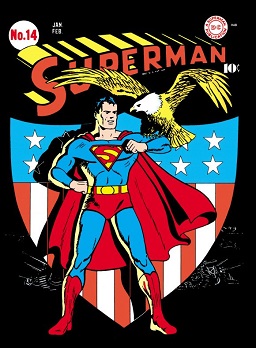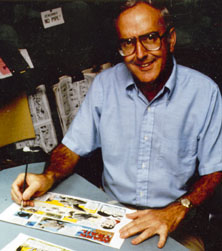Notes
- ↑ Rhoades, Shirrel (2008). A Complete History of American Comic Books. Peter Lang. p. 52. ISBN 9781433101076 . Retrieved 30 December 2017.
Love Classics was a Marvel comic series, published in 1949. [1]

A comic strip is a sequence of cartoons, arranged in interrelated panels to display brief humor or form a narrative, often serialized, with text in balloons and captions. Traditionally, throughout the 20th and into the 21st century, these have been published in newspapers and magazines, with daily horizontal strips printed in black-and-white in newspapers, while Sunday papers offered longer sequences in special color comics sections. With the advent of the internet, online comic strips began to appear as webcomics.

A comic book, also called comicbook, comic magazine or simply comic, is a publication that consists of comics art in the form of sequential juxtaposed panels that represent individual scenes. Panels are often accompanied by descriptive prose and written narrative, usually, dialogue contained in word balloons emblematic of the comics art form.

DC Comics, Inc. is an American comic book publisher and the flagship unit of DC Entertainment, a subsidiary of Warner Bros. Discovery.

Marvel Comics is an American comic book publisher and the flagship property of Marvel Entertainment, a division of The Walt Disney Company since September 1, 2009. Evolving from Timely Comics in 1939, Magazine Management/Atlas Comics in 1951 and its predecessor, Marvel Mystery Comics, the Marvel Comics title/name/brand was first used in June 1961.

Superman is a superhero who appears in American comic books published by DC Comics. The character was created by writer Jerry Siegel and artist Joe Shuster, and debuted in the comic book Action Comics #1. Superman has been adapted to a number of other media, including radio serials, novels, films, television shows, theater productions, and video games.

A graphic novel is a long-form, fictional work of sequential art. The term graphic novel is often applied broadly, including fiction, non-fiction, and anthologized work, though this practice is highly contested by comics scholars and industry professionals. It is, at least in the United States, typically distinct from the term comic book, which is generally used for comics periodicals and trade paperbacks.

Comic Relief is an operating British charity, founded in 1985 by the comedy scriptwriter Richard Curtis and comedian Lenny Henry in response to the famine in Ethiopia. The concept of Comic Relief was to get British comedians to make the public laugh, while raising money to help people around the world and in the United Kingdom. A new CEO, Samir Patel, was announced in January 2021.

Comics is a medium used to express ideas with images, often combined with text or other visual information. It typically takes the form of a sequence of panels of images. Textual devices such as speech balloons, captions, and onomatopoeia can indicate dialogue, narration, sound effects, or other information. There is no consensus amongst theorists and historians on a definition of comics; some emphasize the combination of images and text, some sequentiality or other image relations, and others historical aspects such as mass reproduction or the use of recurring characters. Cartooning and other forms of illustration are the most common image-making means in comics; fumetti is a form that uses photographic images. Common forms include comic strips, editorial and gag cartoons, and comic books. Since the late 20th century, bound volumes such as graphic novels, comic albums, and tankōbon have become increasingly common, while online webcomics have proliferated in the 21st century.

The Golden Age of Comic Books describes an era of American comic books from 1938 to 1956. During this time, modern comic books were first published and rapidly increased in popularity. The superhero archetype was created and many well-known characters were introduced, including Superman, Batman, Robin, Captain Marvel, Captain America, and Wonder Woman.

A cartoonist is a visual artist who specializes in both drawing and writing cartoons or comics. Cartoonists differ from comics writers or comic book illustrators in that they produce both the literary and graphic components of the work as part of their practice. Cartoonists may work in a variety of formats, including booklets, comic strips, comic books, editorial cartoons, graphic novels, manuals, gag cartoons, storyboards, posters, shirts, books, advertisements, greeting cards, magazines, newspapers, webcomics, and video game packaging.
Blue Beetle is the name of three fictional superheroes appearing in a number of American comic books published by a variety of companies since 1939. The most recent of the companies to own rights to Blue Beetle is DC Comics, which bought the rights to the character in 1983, using the name for three distinct characters over the years.

The Will Eisner Comic Industry Awards, commonly shortened to the Eisner Awards, are prizes given for creative achievement in American comic books, referred to as the comics industry's equivalent to the Academy Awards. The awards are regarded by many as the most prestigious, significant awards in the comics industry. They are named in honor of the pioneering writer and artist Will Eisner, who was a regular participant in the award ceremony until his death in 2005. The Eisner Awards include the Comic Industry's Hall of Fame.

Comic Sans MS is a sans-serif typeface designed by Vincent Connare and released in 1994 by Microsoft Corporation. It is a non-connecting script inspired by comic book lettering, intended for use in cartoon speech bubbles, as well as in other casual environments, like informal documents and children's materials.

An American comic book is a thin periodical originating in the United States, on average 32 pages, containing comics. While the form originated in 1933, American comic books first gained popularity after the 1938 publication of Action Comics, which included the debut of the superhero Superman. This was followed by a superhero boom that lasted until the end of World War II. After the war, while superheroes were marginalized, the comic book industry rapidly expanded and genres such as horror, crime, science fiction and romance became popular. The 1950s saw a gradual decline, due to a shift away from print media in the wake of television & television shows and the impact of the Comics Code Authority. The late 1950s and the 1960s saw a superhero revival and superheroes remained the dominant character archetype throughout the late 20th century into the 21st century.

San Diego Comic-Con International is a comic book convention and nonprofit multi-genre entertainment event held annually in San Diego, California, since 1970. The name, as given on its website, is Comic-Con International: San Diego; but it is commonly known simply as Comic-Con or the San Diego Comic-Con or SDCC.

Shogakukan Inc. is a Japanese publisher of dictionaries, literature, comics (manga), non-fiction, DVDs, and other media in Japan.

In comics, a one-shot is a work composed of a single standalone issue or chapter, contrasting a limited series or ongoing series, which are composed of multiple issues or chapters. One-shots date back to the early 19th century, published in newspapers, and today may be in the form of single published comic books, parts of comic magazines/anthologies or published online in websites. In the marketing industry, some one-shots are used as promotion tools that tie in with existing productions, movies, video games or television shows.

Comic Book Resources, also known by the initialism CBR, is a website dedicated to the coverage of comic book–related news and discussion.

Stan Lee was an American comic book writer, editor, publisher, and producer. He rose through the ranks of a family-run business called Timely Comics which would later become Marvel Comics. He was the primary creative leader for two decades, leading its expansion from a small division of a publishing house to a multimedia corporation that dominated the comics and film industries.

Comedy is a genre of fiction that consists of discourses or works intended to be humorous or amusing by inducing laughter, especially in theatre, film, stand-up comedy, television, radio, books, or any other entertainment medium. The term originated in ancient Greece: In Athenian democracy, the public opinion of voters was influenced by political satire performed by comic poets in theaters. The theatrical genre of Greek comedy can be described as a dramatic performance pitting two groups, ages, genders, or societies against each other in an amusing agon or conflict. Northrop Frye depicted these two opposing sides as a "Society of Youth" and a "Society of the Old". A revised view characterizes the essential agon of comedy as a struggle between a relatively powerless youth and the societal conventions posing obstacles to his hopes. In this struggle, the youth then becomes constrained by his lack of social authority, and is left with little choice but to resort to ruses which engender dramatic irony, which provokes laughter.